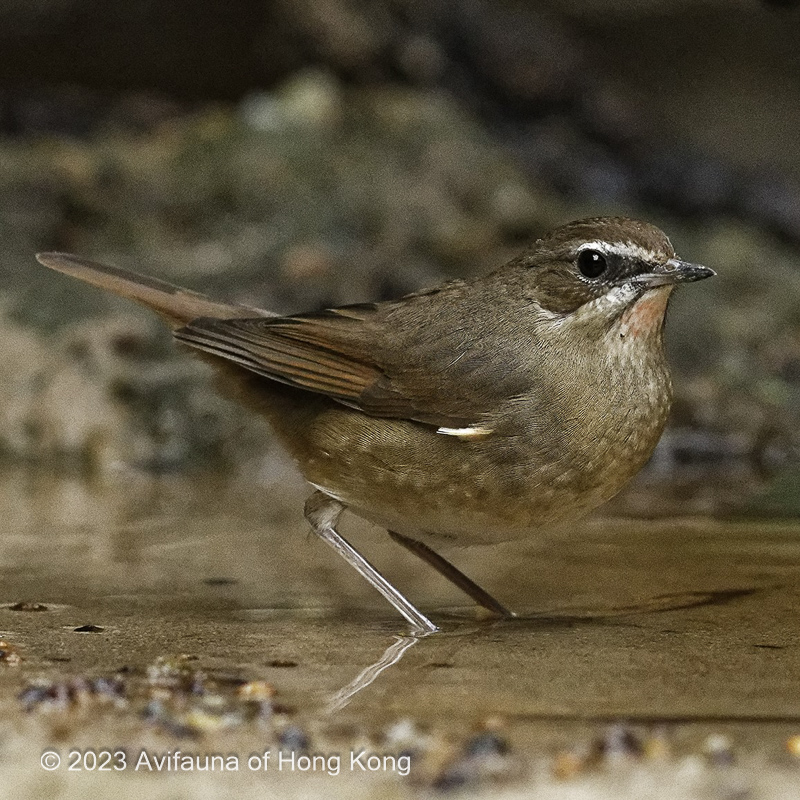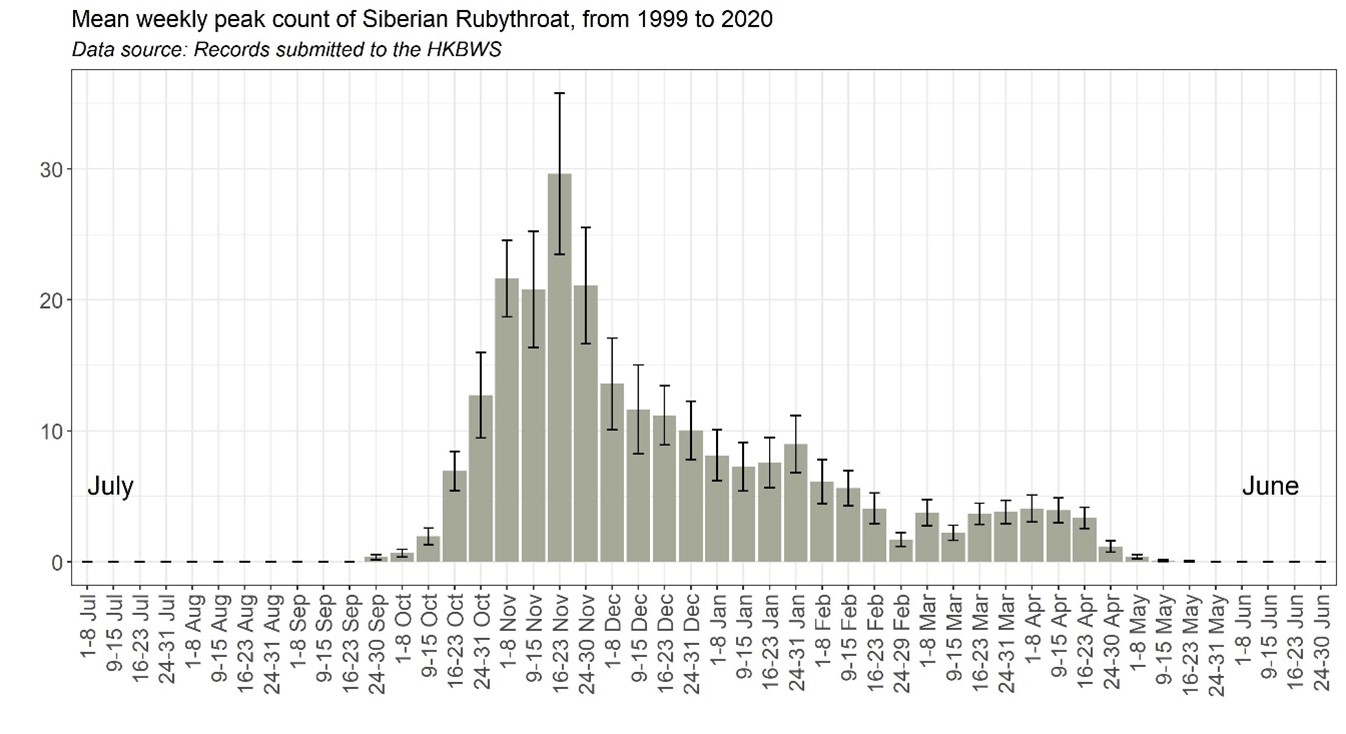Siberian Rubythroat Calliope calliope 紅喉歌鴝
Category I. Common winter visitor and passage migrant to open- and closed-canopy shrubland, reed marsh, mangrove edge and open country areas with shrubs.
IDENTIFICATION

Jan. 2014, Martin Hale.
14-16 cm. The male has a striking facial pattern with a white supercilium, dark lores, a white submoustachial stripe, bright red chin and throat, and a narrow black necklace (sometimes absent) separating the red throat from grey (occasionally brown) breast.

Dec. 2017, Guy Miller.
The female shows a white supercilium, darkish lores, a whitish submoustachial stripe and a white to pink/reddish throat. Atypical adult females have markings close to adult males and can be difficult to separate.
First-year birds are like the respective adults but with generally duller plumage and pale tips to the greater coverts.
VOCALISATIONS
A vocal species that utters three call types throughout the winter and low-intensity song mainly in early winter and early spring.
The first and lowest in pitch is a short ‘chook’ that often has a slightly nasal timbre.
The second is a short, inflected ‘cheek’
The third is purest in tone but also the most variable. It can be slightly drawn out and audibly downslurred.
Or it can be short and even in pitch or longer and rising with a terminal fall in pitch.
The song heard in HK is highly variable in structure and consists of a jumble of harsh and pure notes; it is most easily identified by its timbre.
DISTRIBUTION & HABITAT PREFERENCE
An open country species that occurs in grassland/shrubland, rank grassland, shrubland, mangrove edge and reed marsh.
A striking decline in its distribution was recorded in the 2016-19 Winter Atlas surveys in which it was recorded in 9.4% of 1km squares, compared with 24% in the 2001-05 surveys. This is despite the increase in numbers recorded across winter periods since 1999. Declines were most noticeable in Sai Kung, Lion Rock and Ma On Shan Country Parks, northeast New Territories, eastern HK Island and western Lantau.
It is likely the maturation of earlier succession stage habitats to closed-canopy woodland has been a factor in this, although this may not be the only one. The striking throat colour and song makes this an attractive species in the wild bird trade.
OCCURRENCE
Siberian Rubythroat is a common winter visitor and passage migrant with extreme dates of 24 September and 11 May.
Scarce in the territory until the last week of October, it is subsequently common until the end of January (Figure 1). Peak numbers occur in November, particularly in the third week of the month, when it is presumed both passage migrants and arriving wintering birds are present. Fewer are recorded from February to the middle of March. There appears to be a weak passage in the second half of March and the first three weeks of April, after when it is rare.
Most reports are of ones or twos, but higher numbers have been recorded at favoured sites. Surveys on Po Toi in the late 1990s turned up 59 (the highest on record) on 27 November 1996 and 41 on 9 April 1997. Peak annual counts from 1999/2000 to 2019/20 varied from six to 40, the latter at Mai Po on 23 November 2002.
Regular ringing in reed marsh at Mai Po has established that some birds remain in the same area during the winter season, e.g., a first-year male ringed on 23 November 2012 was recaptured on 7 January 2013 and again on 12 April 2013 after 140 days. Apart from intraseasonal site fidelity, there have also been many examples of birds returning in different winters, the most notable being a first-year female ringed on 30 November 2010 that was recaptured in 2013/14 and 2014/15; its final recapture was on 5 November 2015, four years and 340 days after it was initially trapped.
The sum of weekly counts varied from a low of 43 in the 1999/2000 winter to a high of 689 in 2017/18, part of a rise in numbers in recent winter periods that is considered due to an increase in observer activity and reporting.
Vaughan and Jones (1913) stated that it was seldom seen due to its skulking habits and considered it a rather rare winter visitor to the Pearl River delta. It was first recorded in HK on 2 February 1936 (Herklots 1936). Only three further individuals up to 1941 were recorded by Herklots (1953). The scarcity was probably due to a lack of familiarity with the vocalisations.
BEHAVIOUR, FORAGING & DIET
Skulking and elusive, it forages on the ground or low in vegetation for insects. Usually detected by its call and sub-song. Males hold winter territories which they advertise by both call and sub-song, the latter mainly late autumn and early winter.
RANGE & SYSTEMATICS
Siberian Rubythroat breeds from the central Urals and Siberia east to Kamchatka and the Commander Islands, and south to north Mongolia, North Korea, northern Japan and the Kuril Islands; it also breeds in central China.
In China, C. c. calliope breeds in Inner Mongolia, Jilin and Heilongjiang and winters from Yunnan east to south Guangdong and HK. It occurs as a passage migrant across eastern China. C. c. beicki breeds in Qinghai, Gansu and Sichuan and presumably winters in southeast Asia. C. c. camtschatkensis breeds in Kamchatka, the Commander islands, the Kuril Islands and north Japan, and winters in southeast Asia and the Philippines (Clement and Rose 2015, Collar 2020, Liu and Chen 2020).
CONSERVATION STATUS
IUCN: Least Concern. Population trend stable.
Figure 1.

Clement, P. and C. Rose (2015). Robins and Chats. Christopher Helm, London.
Collar, N. (2020). Siberian Rubythroat (Calliope calliope), version 1.0. In Birds of the World (J. del Hoyo, A. Elliott, J. Sargatal, D. A. Christie, and E. de Juana, Editors). Cornell Lab of Ornithology, Ithaca, NY, USA. https://doi.org/10.2173/bow.sibrub.01
Herklots, G.A.C. (1936). Notes and comments. Ornithology. Hong Kong Naturalist 7: 81-86.
Herklots, G.A.C. (1953). Hong Kong Birds. South China Morning Post, Hong Kong.
Vaughan, R. E. and K. H. Jones (1913). The birds of Hong Kong, Macao and the West River or Si Kiang in South-East China, with special reference to their nidification and seasonal movements. Ibis 1913: 17-76, 163-201, 351-384.
Liu, Y. and Y. H. Chen (2020). The CNG Field Guide to the Birds of China (in Chinese). Hunan Science and Technology Publication House.

